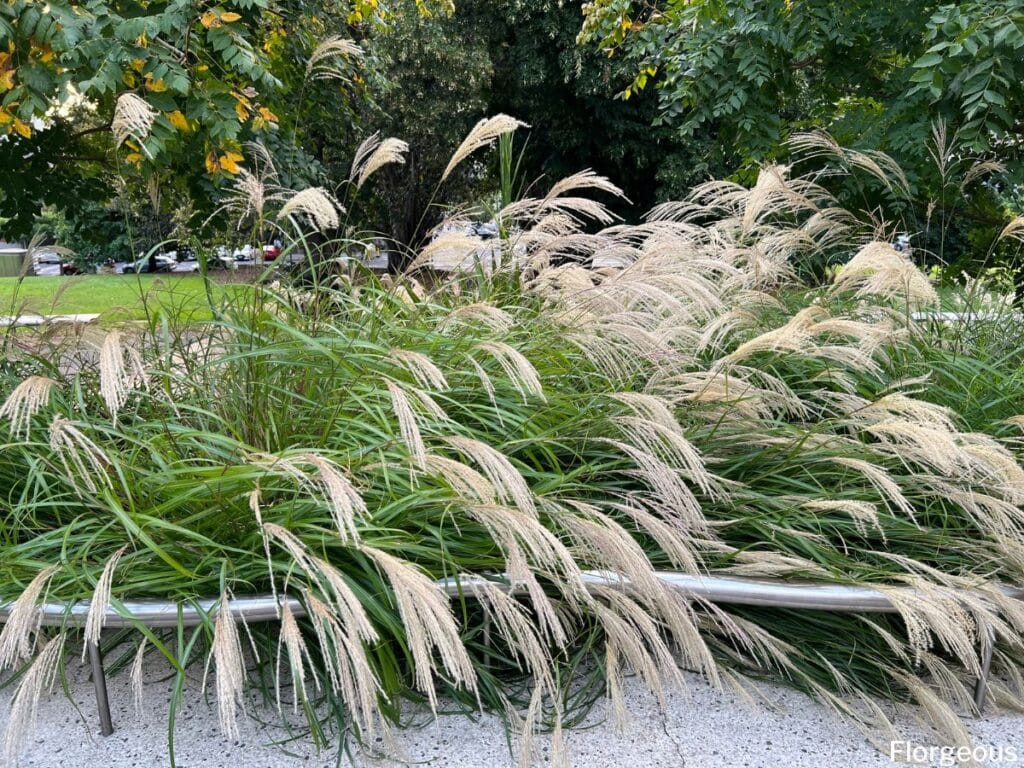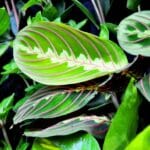Ornamental grasses can look charming in garden spaces because these plants will add lots of texture to your yard with their tall leaf blades and delicate foliage.
The wavy leaves will also add lots of vertical interest to your spaces and can create the illusion of wavy movement all over your spaces.
There are many different types of decorative grasses that can be mixed together to formulate interesting spaces or paired with other ornamental plant species like flowers to create a showy effect in your garden.
In this guide, we are going to take a look at 16 of the best ornamental grass types and different ways to use them to enhance the aesthetics of your garden.
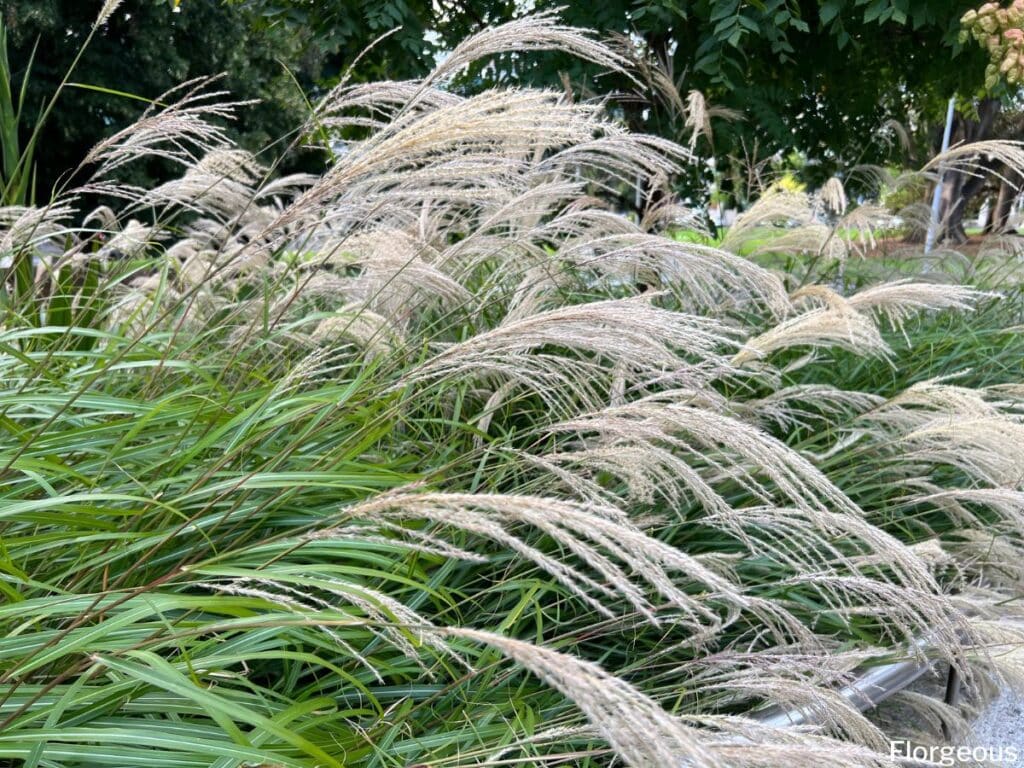
Best Decorative Grasses for Full Sun to Part Shade Gardens
Ornamental grasses can vary a lot in their look and growing requirements. Some species need lots of direct sunlight in order to produce flower heads and to grow well while others might scorch if they are planted in a direct sun position.
Some grass species are drought tolerant and can flop over if they are overwatered while others rely on moist conditions for survival.
If your garden is mostly sunny to partially shaded then you can consider the following grass species.
Mexican Feather Grass
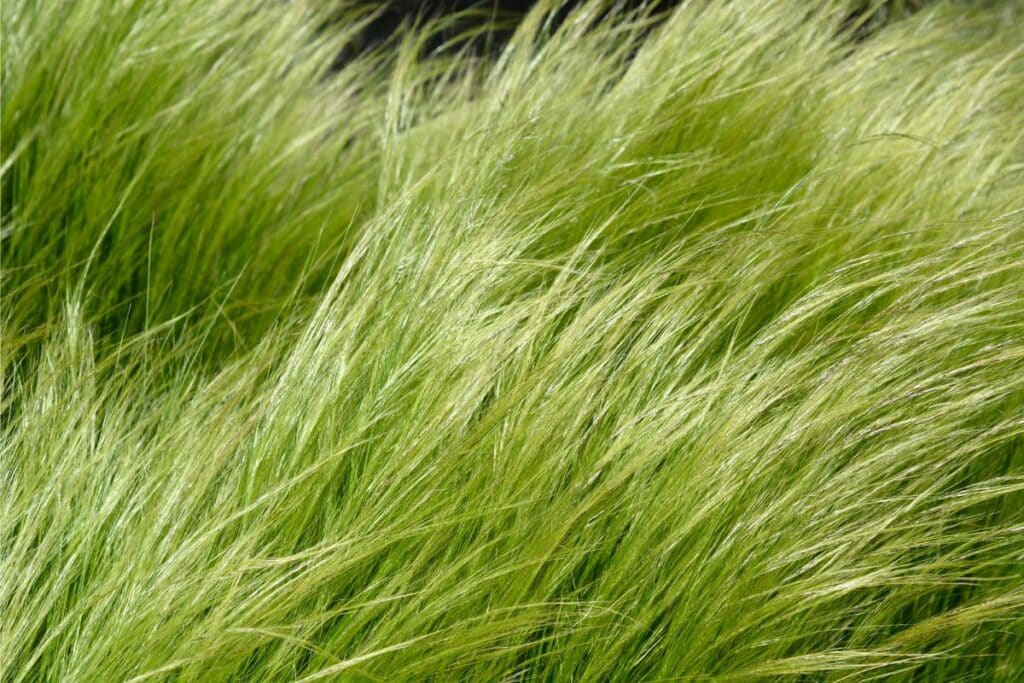
Mexican feather grass (Nassella tenuissima) or Texas tussock grass is one of the most fine-textured plants you can add to your garden.
This grass has thin tall leaf blades and stems that produce fine texture flowers that can create a wispy flowing effect.
The cool-season perennial produces vivid lime green bunches 1 – 2 feet tall. In warmer temperatures or when the grass starts to die back for winter, it will transform into golden hues. During the cold winter, this delicious plant will become dormant and it will re-emerge in early spring.
Mexican feather grass grows best in full sun and it prefers poor soil conditions. The grass variety is very drought tolerant and shouldn’t be watered too often. It is an ideal grass for dry garden spaces or prairies.
Pampas Grass
Pampas grass (Cortaderia selloana) is one of the showiest grasses you can include in your garden.
The grass variety produces delicate blue-green leaves that can fill out your garden spaces. It is mostly grown for its showy flowering stalks that can reach a height of up to 4 meters tall and varieties can vary from white flowers to purple tones.
This showy plant is evergreen in warmer regions. It produces new growth from early spring, and flowers from spring to fall, and the leaves can become gold-toned during the colder months. These perennial grass plants do, however, take up to 3 years to reach maturity and to flower properly.
You can plant pampas grass in full sun to partial shade but not in full shade. These grasses will take well to any well-drained soil and it shouldn’t be watered very often because it is very drought-tolerant.
Fountain Grass

Fountain grass (Pennisetum setaceum) is great for filling out garden beds and will add vertical interest with its tall grass blades that create a fountain-like effect. The grass also produces feathery plumes in hues of white to pinkish-red on tall spikes which can give your garden a whimsical appearance.
This evergreen perennial will add year-round interest to your garden. During spring, the grass will bloom vigorously and it will create lots of lush green growth.
In fall, the grass will transform into golden hues and it will become straw-colored during the colder months which can add lots of winter interest. In colder regions, it will die back for the winter.
Fountain grass will grow well in full sun conditions but it can tolerate a little bit of shade. The grass takes well to most soil types and it should be watered one to two times a week.
Muhly Grass
Muhly grass (Muhlenbergia capillaris) or pink hair grass is perfect for ornamental gardens because it creates vivid pink or reddish flower stalks that can soften up and brighten your garden spaces.
This semi-evergreen grass can become quite tall with a height of up to 5 feet tall. The grass will produce lots of pink clusters from summer to late fall and can transform into yellow or brown tones during winter.
Muhly grass prefers a full sun position but it can also grow part shade and the soil should be left to dry out fully before watering again.
Feather Reed Grass

Feather reed grass (Calamagrostis acutiflora) or Karl Foerster grass is one of the most popular statement grasses. This clump-forming grass is quite tall and produces vivid yellow-toned flowers that can look incredible in ornamental gardens or in mass plantings.
Karl Foerster grass is an evergreen perennial grass plant and will stay upright throughout the year. The dense clumps are great for keeping your garden full when other plants die back for winter.
This ornamental grass produces pink-purple flowers in summer, followed by tan or golden seeds from fall to early winter. In winter, the grass blades will become pale yellow and can be pruned just before spring.
This grass variety prefers full sun with rich soil but it should be planted in well-drained soil and watered regularly.
See more: Karl Foerster Grass Companion Plants
Chinese Silver Grass
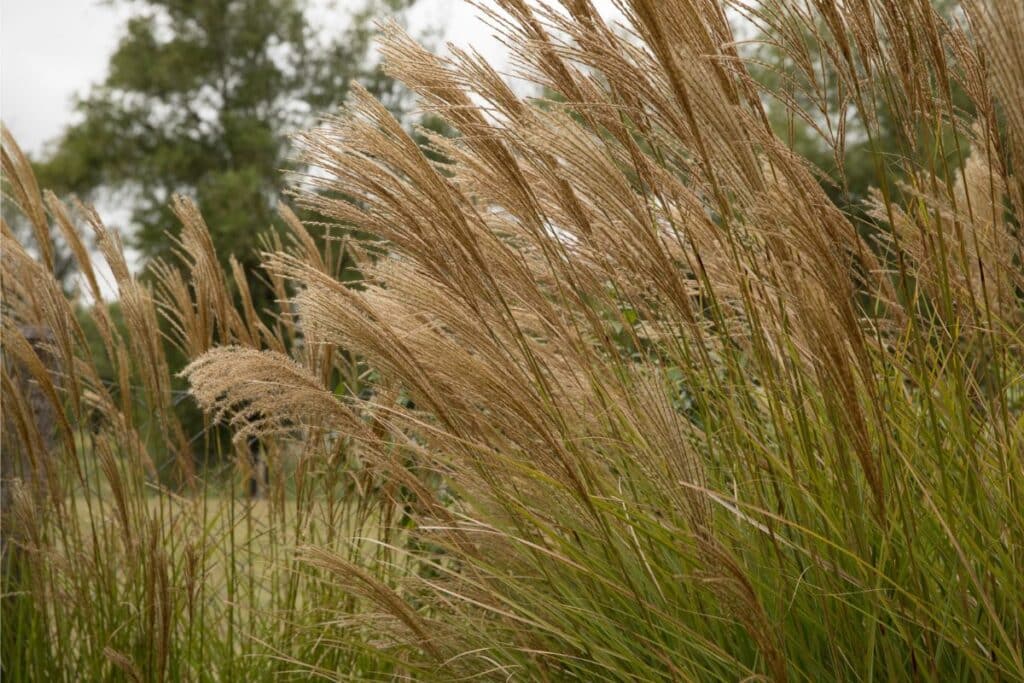
Chinese Silver Grass (Miscanthus sinensis) which includes varieties like porcupine grass, maiden grass, and zebra grass will produce enormous bunches and can reach tall heights of up to 12 feet.
It produces showy blooms and can be grown individually as accent plants or in groups to produce hedges or borders. Some varieties produce interesting leaves with striped patterns.
There are quite a few different cultivars and the flower colors can vary for different types and it can be deciduous or evergreen. The airy blooms or seed heads usually appear from late summer to early fall and the leaves can become golden and dull in winter. These leaves need to be trimmed back in late winter to boost new growth in spring.
These grasses need a full sun position with a minimum of 6 hours of direct sun but they may survive in light shade in warmer regions. This grass variety can be grown in any type of well-drained soil but it should be kept moist.
Blue Oat Grass

Blue oat grass (Helictotrichon sempervirens) can add lots of contrast and texture to your garden because it has tall, fine textured leaves that become blue-green in a full sun position. The fountain-like clumps can be used as accent plants in containers or mass planted in prairies or to create showy borders.
In cooler areas, the grass variety is semi-evergreen and it can be evergreen in warmer regions. For a showy blue-green hues, you should place it in full sun but it can also grow in partial shade although it will become green-hued and might not flower in shaded areas.
Blue oat grass should be watered regularly but the soil shouldn’t be too moist or too dry.
Switchgrass
Switchgrass (Panicum virgatum) is a good selection for large spaces and prairies because it looks best in mass plantings.
This prairie grass produces finely textured reddish purple seed heads that can add lots of color to your spaces and its delicate appearance will soften up the look of your garden.
These perennial grasses grow vigorously in summer with lots of green foliage. In late summer to fall it will produce lots of finely textured blooms and the grass will become golden-colored during the colder months. Switchgrass acts like annual grasses and dies back for the winter but they will re-emerge again in late spring.
These tall grasses grow best in full sun and moist soil but can be drought-tolerant in colder regions.
Blue Fescue Grass
Blue fescue (Festuca glauca) is a showy grass that produces interesting fountain-like clumps and it is mostly grown for its showy blue-tinted leaves.
The showy grass looks best from spring to fall because the foliage is at its richest blue tones during this time. In cold areas, the grass will turn brown during winter but it will add lots of winter interest even in this state because the upright clumps are still attractive even in this state.
Blue fescue can be grown in full sun to partial shade but won’t flower and will turn green instead of blue in shaded areas. Once established, these perennials can be drought tolerant.
Big Bluestem
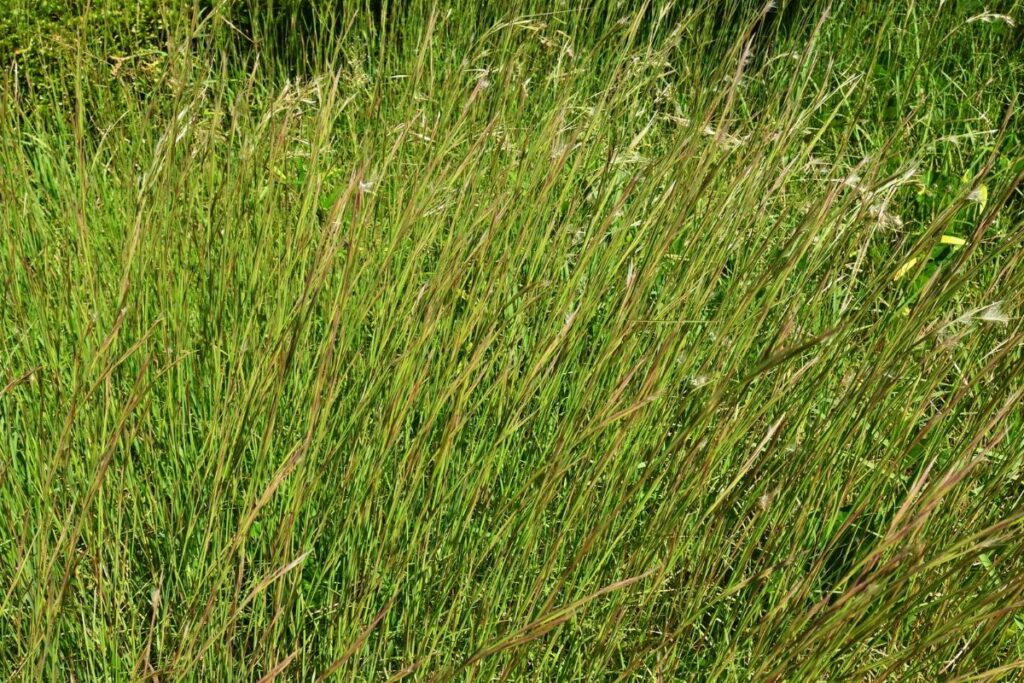
Big bluestem (Andropogon gerardii) are native grasses that can be grown for ornamental or agricultural purposes because it is attractive yet can be used as a forage grass for animals.
This grass with its powder blue foliage produces vigorous growth during the warm summer months and will add lots of fall interest with showy seed heads that look so charming when they sway in the wind. The grass will become gold/brown colored in early winter before becoming dormant for the colder season.
Big bluestem should be planted in full sun and well-drained soil and it can be drought tolerant.
Little Bluestem
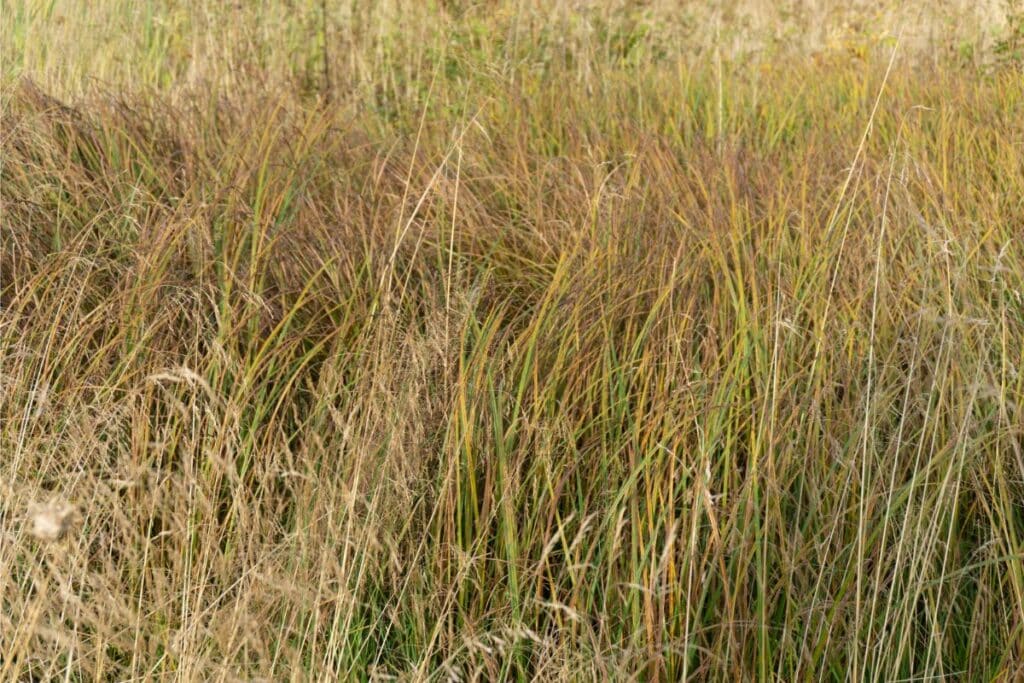
Little bluestem (Schizachyrium) or beard grass looks very similar to big bluestem but it is finer in texture and shorter.
These grasses for landscaping produce light blue foliage in spring that turns dark grey-green in summer. In fall, the leaves can become pinkish orange, reddish-purple, or even vibrant red and they will become oat colored before dying back in winter.
The native grass should be planted in full sun with moist to dry soil depending on the climate.
Best Ornamental Grasses for Full Shade to Part Sun Gardens
Sun-dependent grass varieties tend to flop over if they are planted in shaded positions.
If your garden is mostly shaded then it is better to focus on grass varieties that prefer moist and shaded positions. Here is a quick look at some of the best species to add to shaded gardens.
Japanese Forest Grass
Japanese forest grass (Hakonechloa macra) or Hakone grass is one of the most beautiful grasses for landscaping because it produces wide and showy lime green arching foliage that can brighten up your spaces and fill out your garden.
These perennial ornamental grasses look their best from spring to fall. In warmer regions, the leaves will become brown during winter and they will die back and become dormant in colder regions when it is winter.
These cool grasses will grow well in partial shade and their roots should be kept cool and moist or they can easily wilt.
Ribbon Grass
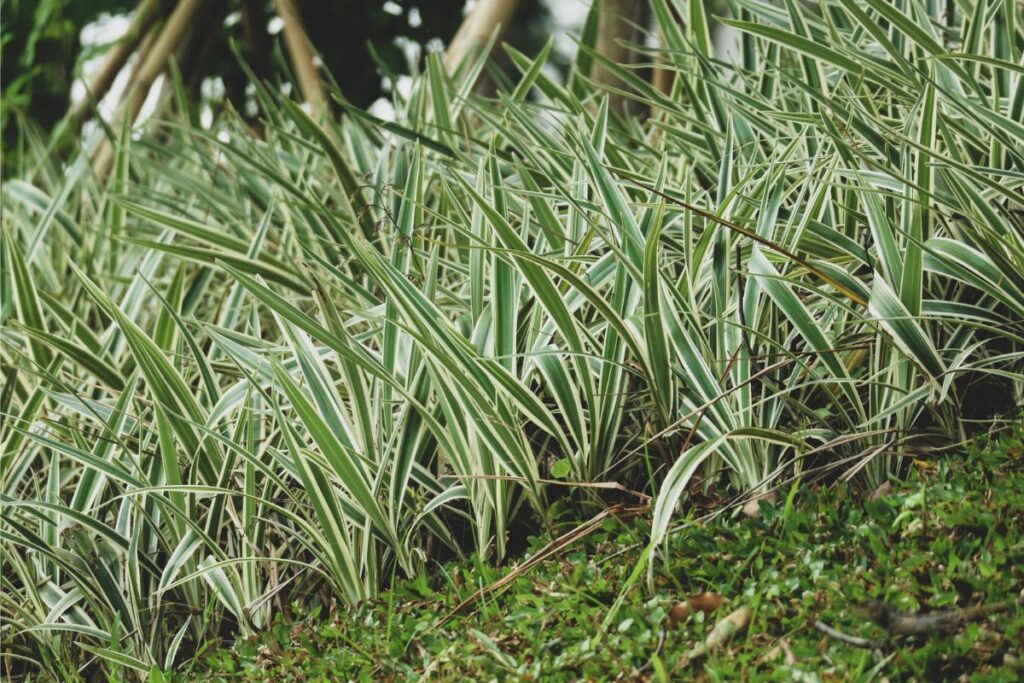
Ribbon grass (Phalaris arundinacea) or reed canary grass looks rather striking with its striped leaves and it produces tiny pink or purple flowers. This is a very handy grass to grow if you are looking for garden fillers or ground covers because it can quickly spread all over your garden bed.
Ribbon grass is evergreen and spreads by rhizomes. These plants can spread rapidly and are perfect for creating low-maintenance gardens or for keeping your beds full during winter.
This ornamental grass can be planted in full to partial sun and it can tolerate dry to wet conditions but should be planted in well-drained soil.
Mondo Grass
Mondo grass (Ophiopogon japonicus), also known as monkey grass or dwarf lilyturf, is a very interesting low-growing ornamental grass that can be used as borders around flower beds or alongside walkways.
There are a couple of varieties of this clump-forming evergreen grass and they can appear different in different areas.
They can be grown in full sun but can scorch in warmer climates. These green grasses grow best in partial shade to deep shade positions and the foliage will become darker in darker shade positions. Black mondo grass, for example, will appear jet black if you grow it in deep shade or dark green in light shade.
This self-spreading grass requires weekly watering and it will take well to most soil types.
Golden Wood Millet
Golden wood millet (Milium effusum ‘aureum’) or millet grass is great for brightening up spaces because it has broad leaves in vivid lime green tones.
This evergreen plant will die back for the winter and can look airy and greenish-yellow from spring to late summer. From fall, the grasses will start to gradually die back until it is entirely dormant.
Golden wood millet is quite flexible since you can grow it in partial shade to full shade with average to moist soil.
Northern Sea Oats
Northern sea oats (Chasmanthium latifolium), also known as inland sea oats or river oats, produce interesting seeds in colors that range from white to pinkish and their dense shrub-like appearance is great for filling out large spaces in your garden.
This plant will grow vigorously from spring to late fall and will transform into brown or golden tones as it dies back in winter. The dried leaves and seed heads will create lots of interest in your garden in winter and can be used in flower arrangements.
This grass variety can be grown in partial shade to full shade with moderate watering or even in full sun if you keep the roots moist.
Landscaping Ideas for Decorative Grass Plants
Ornamental grass can be used to create all sorts of showy spaces and you can combine different varieties to create different effects.
Here is a quick look at some of the most popular ways these grasses are used in gardens.
Container Gardens
You can plant garden grasses in mixed containers to create a showy thriller effect along with a bright flowering species like geranium as a filler plant and a vine plant as a spiller. These types of mixed container arrangements can create a very attractive effect.
Some gardeners also love to pair different varieties of ornamental grasses each in their own container and pair them together so the differences between these species will be accentuated.
Hedges
Most ornamental grass species can be used to create borders or hedges. For driveways or garden edging, you might want to focus on taller species but for garden bed edging or walkway edging, shorter varieties like mondo grass might be more functional.
Rocky Gardens
Ornamental grass is great for softening up the look of rocky gardens. It is best to mix clumps of soft-texture grasses with flowering species to create gardens that appear rich and full of life.
Dry Garden Spaces
Ornamental grass is an ideal plant to use in dry garden spaces or xeriscape projects because the clumps of soft grass will add lots of vertical interest and can create a sense of movement.
You can combine water-efficient ornamental grasses with other drought-tolerant plant species to create showy gardens that are easy to maintain and that don’t need much watering.
Final Thoughts
There are many different types of ornamental grasses that you can use to create interesting spaces in your landscapes.
Mexican feather grass, pampas grass, fountain grass, muhly grass, feather reed grass, Chinese silver grass, blue oat grass, switchgrass, blue fescue grass, big bluestem, little bluestem, japanese forest grass, ribbon grass, mondo grass, golden wood millet, and northern sea oats are some of the most common ornamental grass varieties used in gardens and can all be wonderful editions if you want to create showy spaces.
We hope that this guide gave you some helpful insight into the right grass variety to select for your garden and that you had lots of fun discovering new grass varieties that can be used for decorative purposes.
You can check more ornamental plants to grow in your garden.
Reference List
References
- https://hles.unl.edu/northern-sea-oats
- https://besjournals.onlinelibrary.wiley.com/doi/full/10.1111/1365-2745.12744
- https://plants.ces.ncsu.edu/plants/ophiopogon-japonicus/
- https://ucanr.edu/blogs/blogcore/postdetail.cfm?postnum=14457
- https://hgic.clemson.edu/factsheet/ornamental-grasses-and-grass-like-plants/
- https://plants.ces.ncsu.edu/plants/muhlenbergia-capillaris/
- https://hortnews.extension.iastate.edu/1997/4-11-1997/featherreed.html
- https://extension.uga.edu/publications/detail.html?number=C983&title=pampas-grass
- https://www.bellarmine.edu/faculty/drobinson/ChineseSilvergrass.asp
- https://edis.ifas.ufl.edu/publication/FP251
- http://switchgrass.okstate.edu/what-is-switchgrass
- https://hort.extension.wisc.edu/articles/blue-fescue-festuca-ovina-glauca/
- https://extension.okstate.edu/programs/plant-id/plant-profiles/big-bluestem/
- https://hort.extension.wisc.edu/articles/japanese-forest-grass-hakonechloa-macra/
- https://plants.ces.ncsu.edu/plants/phalaris-arundinacea-picta/
Close

